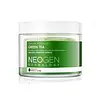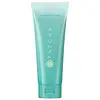What's inside
What's inside
 Key Ingredients
Key Ingredients

 Benefits
Benefits

 Concerns
Concerns

 Ingredients Side-by-side
Ingredients Side-by-side

Water
Skin ConditioningDipropylene Glycol
HumectantCamellia Sinensis Leaf Extract
AntimicrobialGlycerin
HumectantAlcohol Denat.
AntimicrobialPEG/PPG-17/6 Copolymer
SolventCentella Asiatica Extract
CleansingArtemisia Vulgaris Extract
Skin ConditioningAloe Barbadensis Leaf Extract
EmollientHouttuynia Cordata Extract
Skin ConditioningGardenia Florida Fruit Extract
Skin ConditioningMelaleuca Alternifolia Leaf Extract
PerfumingCoptis Japonica Extract
AntimicrobialButylene Glycol
HumectantBenzophenone-5
UV AbsorberSodium Hyaluronate
HumectantCarbomer
Emulsion StabilisingTartaric Acid
BufferingGlycolic Acid
BufferingLactic Acid
BufferingTromethamine
BufferingPEG-60 Hydrogenated Castor Oil
EmulsifyingPhenoxyethanol
PreservativeEthylhexylglycerin
Skin Conditioning1,2-Hexanediol
Skin ConditioningMelaleuca Alternifolia Leaf Oil
AntioxidantDisodium EDTA
Parfum
MaskingWater, Dipropylene Glycol, Camellia Sinensis Leaf Extract, Glycerin, Alcohol Denat., PEG/PPG-17/6 Copolymer, Centella Asiatica Extract, Artemisia Vulgaris Extract, Aloe Barbadensis Leaf Extract, Houttuynia Cordata Extract, Gardenia Florida Fruit Extract, Melaleuca Alternifolia Leaf Extract, Coptis Japonica Extract, Butylene Glycol, Benzophenone-5, Sodium Hyaluronate, Carbomer, Tartaric Acid, Glycolic Acid, Lactic Acid, Tromethamine, PEG-60 Hydrogenated Castor Oil, Phenoxyethanol, Ethylhexylglycerin, 1,2-Hexanediol, Melaleuca Alternifolia Leaf Oil, Disodium EDTA, Parfum
Water
Skin ConditioningSodium Cocoyl Glutamate
CleansingPropanediol
SolventGlycerin
HumectantAcrylates Copolymer
Coco-Betaine
CleansingCamellia Sinensis Leaf
PerfumingLuffa Cylindrica Fruit/Leaf/Stem Extract
Skin ConditioningLuffa Cylindrica Fruit
AbrasiveSodium Lauroyl Hydrolyzed Silk
Skin ConditioningRosa Multiflora Fruit Extract
MaskingBelamcanda Chinensis Root Extract
Skin ConditioningPotassium Hydroxide
BufferingSodium Chloride
MaskingPolyglyceryl-10 Dioleate
EmulsifyingPolyglyceryl-2 Sesquicaprylate
EmulsifyingButylene Glycol
HumectantEthylhexylglycerin
Skin ConditioningTetrasodium EDTA
Parfum
MaskingAlcohol
AntimicrobialPhenoxyethanol
PreservativeWater, Sodium Cocoyl Glutamate, Propanediol, Glycerin, Acrylates Copolymer, Coco-Betaine, Camellia Sinensis Leaf, Luffa Cylindrica Fruit/Leaf/Stem Extract, Luffa Cylindrica Fruit, Sodium Lauroyl Hydrolyzed Silk, Rosa Multiflora Fruit Extract, Belamcanda Chinensis Root Extract, Potassium Hydroxide, Sodium Chloride, Polyglyceryl-10 Dioleate, Polyglyceryl-2 Sesquicaprylate, Butylene Glycol, Ethylhexylglycerin, Tetrasodium EDTA, Parfum, Alcohol, Phenoxyethanol
 Reviews
Reviews

Ingredients Explained
These ingredients are found in both products.
Ingredients higher up in an ingredient list are typically present in a larger amount.
Butylene Glycol (or BG) is used within cosmetic products for a few different reasons:
Overall, Butylene Glycol is a safe and well-rounded ingredient that works well with other ingredients.
Though this ingredient works well with most skin types, some people with sensitive skin may experience a reaction such as allergic rashes, closed comedones, or itchiness.
Learn more about Butylene GlycolEthylhexylglycerin (we can't pronounce this either) is commonly used as a preservative and skin softener. It is derived from glyceryl.
You might see Ethylhexylglycerin often paired with other preservatives such as phenoxyethanol. Ethylhexylglycerin has been found to increase the effectiveness of these other preservatives.
Glycerin is already naturally found in your skin. It helps moisturize and protect your skin.
A study from 2016 found glycerin to be more effective as a humectant than AHAs and hyaluronic acid.
As a humectant, it helps the skin stay hydrated by pulling moisture to your skin. The low molecular weight of glycerin allows it to pull moisture into the deeper layers of your skin.
Hydrated skin improves your skin barrier; Your skin barrier helps protect against irritants and bacteria.
Glycerin has also been found to have antimicrobial and antiviral properties. Due to these properties, glycerin is often used in wound and burn treatments.
In cosmetics, glycerin is usually derived from plants such as soybean or palm. However, it can also be sourced from animals, such as tallow or animal fat.
This ingredient is organic, colorless, odorless, and non-toxic.
Glycerin is the name for this ingredient in American English. British English uses Glycerol/Glycerine.
Learn more about GlycerinParfum is a catch-all term for an ingredient or more that is used to give a scent to products.
Also called "fragrance", this ingredient can be a blend of hundreds of chemicals or plant oils. This means every product with "fragrance" or "parfum" in the ingredients list is a different mixture.
For instance, Habanolide is a proprietary trade name for a specific aroma chemical. When used as a fragrance ingredient in cosmetics, most aroma chemicals fall under the broad labeling category of “FRAGRANCE” or “PARFUM” according to EU and US regulations.
The term 'parfum' or 'fragrance' is not regulated in many countries. In many cases, it is up to the brand to define this term.
For instance, many brands choose to label themselves as "fragrance-free" because they are not using synthetic fragrances. However, their products may still contain ingredients such as essential oils that are considered a fragrance by INCI standards.
One example is Calendula flower extract. Calendula is an essential oil that still imparts a scent or 'fragrance'.
Depending on the blend, the ingredients in the mixture can cause allergies and sensitivities on the skin. Some ingredients that are known EU allergens include linalool and citronellol.
Parfum can also be used to mask or cover an unpleasant scent.
The bottom line is: not all fragrances/parfum/ingredients are created equally. If you are worried about fragrances, we recommend taking a closer look at an ingredient. And of course, we always recommend speaking with a professional.
Learn more about ParfumPhenoxyethanol is a preservative that has germicide, antimicrobial, and aromatic properties. Studies show that phenoxyethanol can prevent microbial growth. By itself, it has a scent that is similar to that of a rose.
It's often used in formulations along with Caprylyl Glycol to preserve the shelf life of products.
Water. It's the most common cosmetic ingredient of all. You'll usually see it at the top of ingredient lists, meaning that it makes up the largest part of the product.
So why is it so popular? Water most often acts as a solvent - this means that it helps dissolve other ingredients into the formulation.
You'll also recognize water as that liquid we all need to stay alive. If you see this, drink a glass of water. Stay hydrated!
Learn more about Water